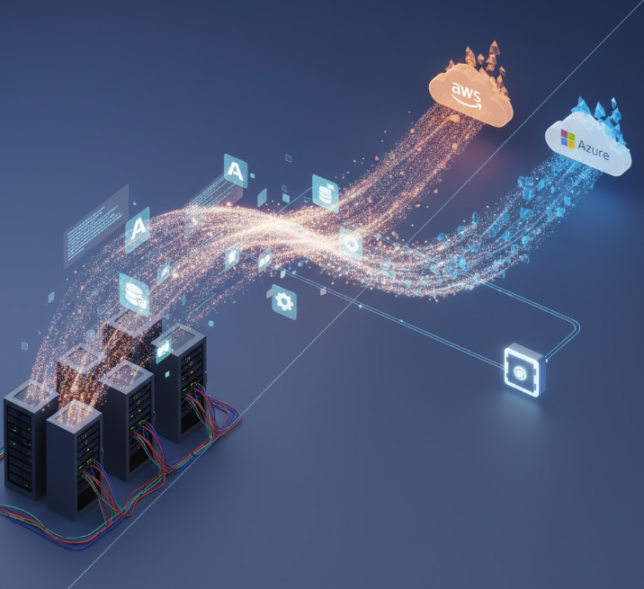✍️ Introduction: Why Cloud Migration Matters
In today’s digital landscape, businesses face growing demands for scalability, flexibility, and cost efficiency. Legacy IT systems can be costly to maintain, slow to adapt, and challenging to secure. Cloud migration provides a strategic solution, enabling enterprises to move applications, data, and workloads to cloud platforms like AWS, Azure, or hybrid environments.

📚 Understanding Cloud Migration
Cloud migration is the process of moving digital assets, services, databases, IT resources, and applications from on-premises infrastructure to the cloud. This can involve:
- Public Cloud Migration: Moving workloads to cloud providers like AWS or Microsoft Azure.
- Private Cloud Migration: Transitioning to a private cloud managed internally or via a vendor.
- Hybrid Cloud Projects: Combining on-premises infrastructure with cloud solutions for flexibility and performance.
Key Steps in a Cloud Migration
| Step | Description |
|---|---|
| Assessment & Planning | Evaluate workloads, dependencies, and business objectives. Identify which apps are suitable for the cloud. |
| Selecting the Cloud Model | Decide between public, private, or hybrid cloud based on security, compliance, and performance needs. |
| Migration Strategy | Choose the migration approach: rehost (lift-and-shift), refactor, re-platform, or rebuild. |
| Execution & Testing | Move workloads in phases, test performance, and ensure data integrity. |
| Optimization & Management | Monitor usage, optimize costs, and apply security best practices. |
⚡ Best Practices for AWS/Azure and Hybrid Cloud Projects
- Prioritize Critical Workloads: Start with non-critical applications to test migration processes.
- Leverage Automation Tools: Use cloud-native tools for deployment, monitoring, and cost optimization.
- Ensure Security & Compliance: Implement identity management, encryption, and audit mechanisms.
- Monitor Performance & Costs: Track KPIs to optimize cloud usage and avoid unexpected expenses.
- Maintain Clear Communication: Keep stakeholders informed to reduce downtime and manage expectations.
❓ FAQs: Cloud Migration
1. What is the difference between public, private, and hybrid cloud?
- Public Cloud: Hosted by third-party providers, scalable, cost-effective.
- Private Cloud: Dedicated infrastructure for your organization, enhanced security.
- Hybrid Cloud: Combines both for flexibility, balancing control and scalability.
2. How long does a typical cloud migration take?
- Timeline depends on workload size and complexity. Small migrations may take weeks, while large enterprise transitions can take months.
3. What are the common challenges in cloud migration?
- Data transfer latency, application compatibility, security concerns, and cost management are key hurdles.
4. How do I ensure a successful hybrid cloud project?
- Thorough planning, selecting the right migration tools, phased execution, and continuous monitoring are critical.
5. Can OmniLegion assist with cloud migration?
- Yes. OmniLegion provides advisory, implementation, and managed services to guide organizations through AWS, Azure, and hybrid migrations.
🤍 Soft CTA
Ready to modernize your IT infrastructure and simplify cloud migration? Partner with OmniLegion for expert guidance on AWS, Azure, and hybrid cloud projects. Our team ensures secure, efficient, and strategic cloud transitions tailored to your business needs.

